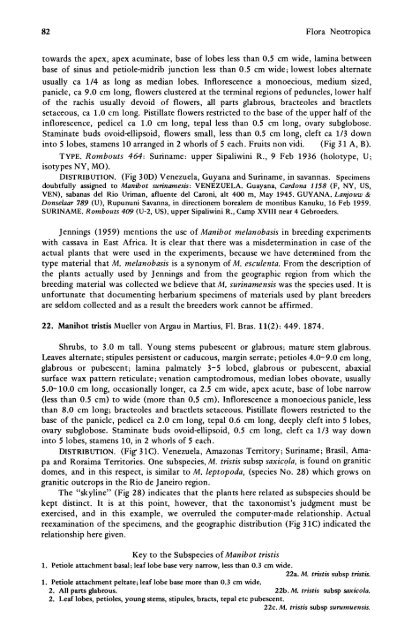Manihot Manihotoides (Euphorbiaceae) - CNCFlora
Manihot Manihotoides (Euphorbiaceae) - CNCFlora
Manihot Manihotoides (Euphorbiaceae) - CNCFlora
Create successful ePaper yourself
Turn your PDF publications into a flip-book with our unique Google optimized e-Paper software.
82 Flora Neotropica<br />
towards the apex, apex acuminate, base of lobes less than 0.5 cm wide, lamina between<br />
base of sinus and petiole-midrib junction less than 0.5 cm wide; lowest lobes alternate<br />
usually ca 1/4 as long as median lobes. Inflorescence a monoecious, medium sized,<br />
panicle, ca 9.0 cm long, flowers clustered at the terminal regions of peduncles, lower half<br />
of the rachis usually devoid of flowers, all parts glabrous, bracteoles and bractlets<br />
setaceous, ca 1.0 cm long. Pistillate flowers restricted to the base of the upper half of the<br />
inflorescence, pedicel ca 1.0 cm long, tepal less than 0.5 cm long, ovary subglobose.<br />
Staminate buds ovoid-ellipsoid, flowers small, less than 0.5 cm long, cleft ca 1/3 down<br />
into 5 lobes, stamens 10 arranged in 2 whorls of 5 each. Fruits non vidi. (Fig 31 A, B).<br />
TYPE. Rombouts 464: Suriname: upper Sipaliwini R., 9 Feb 1936 (holotype, U;<br />
isotypes NY, MO).<br />
DISTRIBUTION. (Fig 30D) Venezuela, Guyana and Suriname, in savannas. Specimens<br />
doubtfully assigned to <strong>Manihot</strong> surinamesis: VENEZUELA. Guayana, Cardona 1158 (F, NY, US,<br />
VEN), sabanas del Rio Uriman, afluente del Caroni, alt 400 m, May 1945. GUYANA. Lanjouw &<br />
Donselaar 789 (U), Rupununi Savanna, in directionem borealem de montibus Kanuku, 16 Feb 1959.<br />
SURINAME. Rombouts 409 (U-2, US), upper Sipaliwini R., Camp XVIII near 4 Gebroeders.<br />
Jennings (1959) mentions the use of <strong>Manihot</strong> melanobasis in breeding experiments<br />
with cassava in East Africa. It is clear that there was a misdetermination in case of the<br />
actual plants that were used in the experiments, because we have determined from the<br />
type material that M. melanobasis is a synonym of M. esculenta. From the description of<br />
the plants actually used by Jennings and from the geographic region from which the<br />
breeding material was collected we believe that M. surinamensis was the species used. It is<br />
unfortunate that documenting herbarium specimens of materials used by plant breeders<br />
are seldom collected and as a result the breeders work cannot be affirmed.<br />
22. <strong>Manihot</strong> tristis Mueller von Argau in Martius, Fl. Bras. 11(2): 449. 1874.<br />
Shrubs, to 3.0 m tall. Young stems pubescent or glabrous; mature stem glabrous.<br />
Leaves alternate; stipules persistent or caducous, margin serrate; petioles 4.0-9.0 cm long,<br />
glabrous or pubescent; lamina palmately 3-5 lobed, glabrous or pubescent, abaxial<br />
surface wax pattern reticulate; venation camptodromous, median lobes obovate, usually<br />
5.0-10.0 cm long, occasionally longer, ca 2.5 cm wide, apex acute, base of lobe narrow<br />
(less than 0.5 cm) to wide (more than 0.5 cm). Inflorescence a monoecious panicle, less<br />
than 8.0 cm long; bracteoles and bractlets setaceous. Pistillate flowers restricted to the<br />
base of the panicle, pedicel ca 2.0 cm long, tepal 0.6 cm long, deeply cleft into 5 lobes,<br />
ovary subglobose. Staminate buds ovoid-ellipsoid, 0.5 cm long, cleft ca 1/3 way down<br />
into 5 lobes, stamens 10, in 2 whorls of 5 each.<br />
DISTRIBUTION. (Fig' 31C). Venezuela, Amazonas Territory; Suriname; Brasil, Ama-<br />
pa and Roraima Territories. One subspecies, M. tristis subsp saxicola, is found on granitic<br />
domes, and in this respect, is similar to M. leptopoda, (species No. 28) which grows on<br />
granitic outcrops in the Rio de Janeiro region.<br />
The "skyline" (Fig 28) indicates that the plants here related as subspecies should be<br />
kept distinct. It is at this point, however, that the taxonomist's judgment must be<br />
exercised, and in this example, we overruled the computer-made relationship. Actual<br />
reexamination of the specimens, and the geographic distribution (Fig 31C) indicated the<br />
relationship here given.<br />
Key to the Subspecies of <strong>Manihot</strong> tristis<br />
1. Petiole attachment basal; leaf lobe base very narrow, less than 0.3 cm wide.<br />
22a. M. tristis subsp tristis.<br />
1. Petiole attachment peltate; leaf lobe base more than 0.3 cm wide.<br />
2. All parts glabrous.<br />
22b. M. tristis subsp saxicola.<br />
2. Leaf lobes, petioles, young stems, stipules, bracts, tepal etc pubescent.<br />
22c. M. tristis subsp surumuensis.

















